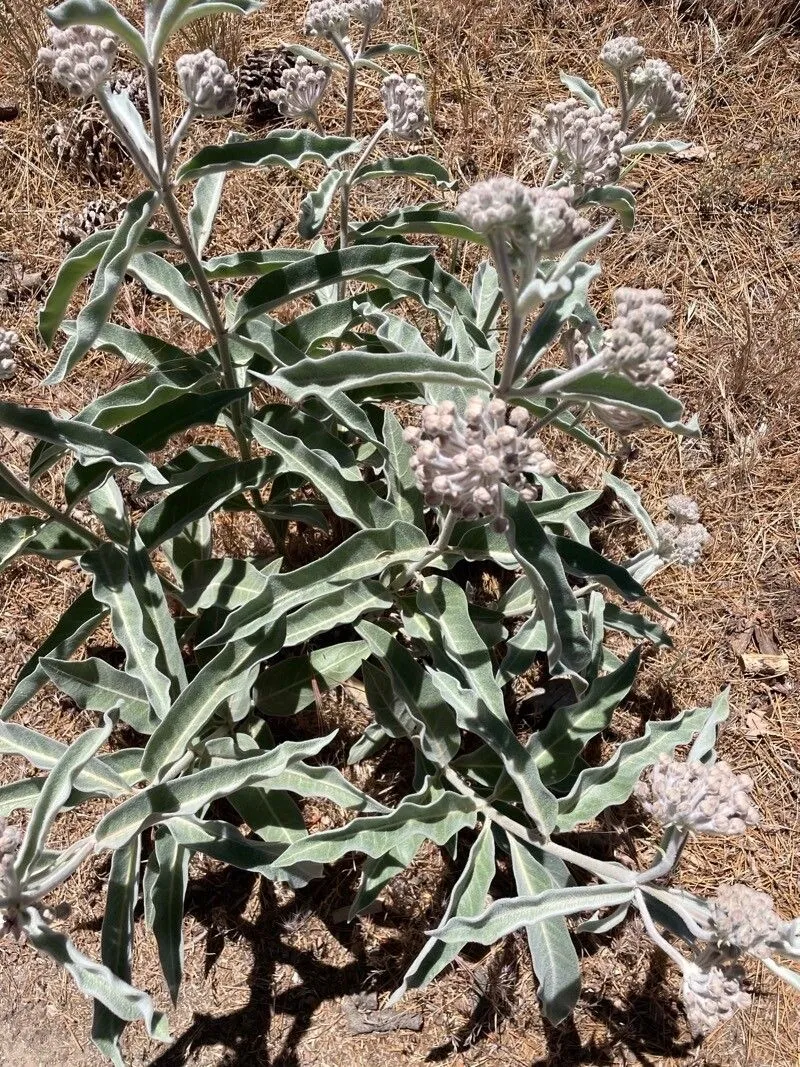
Author: Benth.
Bibliography: Pl. Hartw.: 323 (1849)
Year: 1849
Status: accepted
Rank: species
Genus: Asclepias
Vegetable: Unknown
Observations: California to Mexico (N. Baja California)
Indian milkweed, scientifically known as Asclepias eriocarpa, is a fascinating plant species recognized for its unique characteristics and significant ecological value. This botanical gem belongs to the Apocynaceae family and was first described by the renowned botanist Benth. in his 1849 publication, Pl. Hartw..
This perennial herb can be found in a diverse range of habitats, stretching from the diverse landscapes of California down into the northern region of Baja California in Mexico. It thrives in these regions due to the particular climatic and soil conditions, which provide an ideal environment for its growth.
Indian milkweed is characterized by its tall, robust stems and broad, velvety leaves. The plant is particularly noted for its distinctive milk-white sap, which is a common trait among milkweeds. This sap can be toxic and serves as a natural defense mechanism against herbivores.
The flowers of Asclepias eriocarpa are another remarkable feature. They typically bloom in a cluster and exhibit a creamy to pale yellow color, sometimes with pinkish hues, which adds a delicate beauty to the rugged environments they inhabit. The blooms not only serve an aesthetic purpose but also play a crucial role in the ecosystem. They provide a vital source of nectar for various pollinators, including bees and butterflies, particularly the monarch butterfly, which is known to rely on milkweeds for laying their eggs and nourishing their larvae.
Despite its beauty and ecological benefits, Indian milkweed faces challenges due to habitat destruction and environmental changes. Conservation efforts are important to preserve this species and maintain the balance within its natural habitat.
In summary, Indian milkweed (Asclepias eriocarpa) is a noteworthy plant with distinctive features and significant ecological importance, particularly in supporting pollinator populations. Found from California to northern Baja California, it remains a vital component of its native ecosystem, deserving of continued study and conservation efforts.
Eng: indian milkweed, kotolo, woollypod milkweed
En: Indian milkweed, Kotolo, Woollypod milkweed, Kotolo milkweed
Ar: صقلاب صوفي الثمار
Zh: 毛果乳草
Zh-tw: 毛果乳草
Taken Nov 17, 2015 by EOL − matthew_salkiewicz (cc-by-nc)
Taken May 30, 2015 by EOL − Samantha Ann Dempster (cc-by-nc)
Taken Mar 3, 2013 by EOL − Keir Morse (cc-by-nc-sa)
Taken Jun 13, 2022 by Jake Noll (cc-by-sa)
Taken Jun 13, 2022 by Jake Noll (cc-by-sa)
Taken Jun 10, 2018 by Sandy Rowley (cc-by-sa)
Taken Nov 17, 2015 by EOL − matthew_salkiewicz (cc-by-nc)
Taken Oct 29, 2013 by EOL − Ed Whisler (cc-by-nc)
Taken Mar 3, 2013 by EOL − Keir Morse (cc-by-nc-sa)
Taken Jan 1, 1900 by EOL − Zylstra, J. (cc-by-nc-sa)
Taken Feb 18, 2001 by EOL − Robert Potts (cc-by-nc-sa)
Taken Jul 28, 2015 by EOL − icosahedron (cc-by)
Taken Aug 6, 2013 by EOL − icosahedron (cc-by)
Taken Aug 6, 2013 by EOL − icosahedron (cc-by)
Taken Nov 17, 2015 by EOL − matthew_salkiewicz (cc-by-nc)
Taken Jun 30, 2015 by EOL − Curator, James M. Bryant (cc-by-nc)
Taken Jul 9, 2015 by EOL − Jesse Rorabaugh (cc-by)
Taken Mar 3, 2013 by EOL − Keir Morse (cc-by-nc-sa)
Taken Mar 3, 2013 by EOL − Keir Morse (cc-by-nc-sa)
Taken Feb 24, 1999 by EOL − Beatrice F. Howitt (cc-by-nc-sa)
© copyright of the Board of Trustees of the Royal Botanic Gardens, Kew.
Family: Myrtaceae Author: (F.Muell.) K.D.Hill & L.A.S.Johnson Bibliography: Telopea 6: 402 (1995) Year: 1995 Status:…
Family: Rubiaceae Author: Pierre ex A.Froehner Bibliography: Notizbl. Bot. Gart. Berlin-Dahlem 1: 237 (1897) Year:…
Family: Sapindaceae Author: Koidz. Bibliography: J. Coll. Sci. Imp. Univ. Tokyo 32(1): 38 (1911) Year:…
Family: Asteraceae Author: A.Gray Bibliography: Pacif. Railr. Rep.: 107 (1857) Year: 1857 Status: accepted Rank:…
Family: Fabaceae Author: Medik. Bibliography: Vorles. Churpfälz. Phys.-Ökon. Ges. 2: 398 (1787) Year: 1787 Status:…
Family: Aspleniaceae Author: (Cav.) Alston Bibliography: Bull. Misc. Inform. Kew 1932: 309 (1932) Year: 1932…